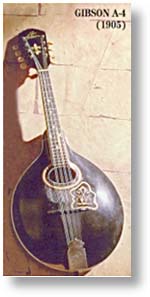Gibson A-4 Mandolin (1905)
 ORVILLE H. GIBSON, WAS BORN IN NEW YORK in 1856, and moved to Kalamazoo, Michigan, as a young man. He began designing and building instruments in the 1880s. In 1898 he was granted a patent for a new design in arch-top instruments. His early instruments were highly experimental and ornate. In 1902, a group of business men bought his patent and formed the Gibson Mandolin-Guitar Co., where Orville remained as a consultant, but not a partner, until 1915. The earliest Gibson instruments have labels that bear his portrait framed in a unique lyre-mandolin, which he had created. This 1905 Gibson A-4 mandolin was a revolutionary instrument in its time - breaking radically away from the traditional “bowl-back” instruments brought to america by Italian immigrants. Instead of having a flat or bent top and a bowlback, Orville’s new design was based on principles of violin construction, using a carved top and back. Though this design was subtly modified over the years, it clearly set the standard for what was to become the preferred style of mandolin used in American folk and popular music. This early version, with a very low bridge, produces an almost banjo-like sound.
ORVILLE H. GIBSON, WAS BORN IN NEW YORK in 1856, and moved to Kalamazoo, Michigan, as a young man. He began designing and building instruments in the 1880s. In 1898 he was granted a patent for a new design in arch-top instruments. His early instruments were highly experimental and ornate. In 1902, a group of business men bought his patent and formed the Gibson Mandolin-Guitar Co., where Orville remained as a consultant, but not a partner, until 1915. The earliest Gibson instruments have labels that bear his portrait framed in a unique lyre-mandolin, which he had created. This 1905 Gibson A-4 mandolin was a revolutionary instrument in its time - breaking radically away from the traditional “bowl-back” instruments brought to america by Italian immigrants. Instead of having a flat or bent top and a bowlback, Orville’s new design was based on principles of violin construction, using a carved top and back. Though this design was subtly modified over the years, it clearly set the standard for what was to become the preferred style of mandolin used in American folk and popular music. This early version, with a very low bridge, produces an almost banjo-like sound.
(from Tone Poems CD booklet, used by permission)
Photography by Eric Harger